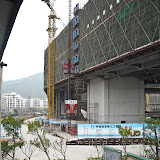LEED in it’s current incarnation is most certainly not the end goal of the green building movement. LEED doesn’t go nearly far enough: even if every building globally achieved the 33% energy savings common in LEED buildings, the world would still be far from achieving the CO2 emission reductions needed to forestall the worst effects of global warming. However, LEED has been an important stepping stone in the journey toward a green built environment. Importantly, LEED has provided a good real world case study in how to successfully transform parts of the real estate market. By studying how LEED transformed the US real estate market and parts of the Chinese real estate market, we can better design a plan for transforming the rest of the Chinese market and achieving the vision of green buildings for everyone, everywhere.
The LEED snowball
LEED has seen massive growth in the US and globally. LEED registrations, i.e. projects committing to seek LEED certification (and paying money to say so), grew from 1000 in 2006 to over 20,000 in 2009. The Green Building Impact Report estimates that "new construction sector penetrations [are] approaching a whopping 40%." This seemingly unstoppable growth is a lot like a snowball rolling down a hill. MIT’s Peter Senge describes the snowball concept in his recent book The Necessary Revolution:
Snowballs arise from an underlying system structure where change feeds on itself to produce more of the same, and soon it snowballs into a pattern of self-reinforcing growth.The underlying system structure of the market for LEED-rated green buildings is a snowball with two parallel and complementary feedback cycles that drive growth.
The first cycle is the demand side. As more green buildings are built, tenants begin to occupy that space and benefit from the green features. As these benefits become publicized and more widely understood, more tenants demand green buildings. Thanks to increased demand, developers build more green buildings. The cycle builds on itself, and the result is more green building.
 At the same time, there is a parallel supply side cycle. As more green buildings are built, developers and builders begin to learn how to make green buildings better and more cheaply. As a result, more tenants can afford green buildings and therefore demand for green buildings increases. This cycle also builds on itself, and the result is more green building.
At the same time, there is a parallel supply side cycle. As more green buildings are built, developers and builders begin to learn how to make green buildings better and more cheaply. As a result, more tenants can afford green buildings and therefore demand for green buildings increases. This cycle also builds on itself, and the result is more green building. More importantly, these two cycles reinforce each other and will eventually result in green building becoming the standard in the market place. The result of this snowballing growth then is nothing less market transformation. The snowball feedback loop helps explain the explosive growth in LEED building. In other words, once the snowball gets big enough, nothing is going to stop it from rolling down the hill. This holds true not only in the US, but also in Tier 1 Chinese Class A markets like Beijing and Shanghai. The same dynamics even seemed to be at work in Dubai before its real estate market collapsed.
More importantly, these two cycles reinforce each other and will eventually result in green building becoming the standard in the market place. The result of this snowballing growth then is nothing less market transformation. The snowball feedback loop helps explain the explosive growth in LEED building. In other words, once the snowball gets big enough, nothing is going to stop it from rolling down the hill. This holds true not only in the US, but also in Tier 1 Chinese Class A markets like Beijing and Shanghai. The same dynamics even seemed to be at work in Dubai before its real estate market collapsed.
The need for snowballs
Interestingly, LEED has achieved this snowballing growth from the bottom up. LEED filled an unmet need in the market place and was able to tap a nascent demand for better, healthier and greener office space. Although the federal and state governments certainly played a role in helping LEED along in the US, the heavy lifting was really done from the bottom up. And in China, besides the Ministry of Science and Technology’s role in Accord 21, almost nothing was done on the part of the government to promote LEED, which illustrates just how thoroughly bottom up LEED’s growth has been in China.
In my next post, I will build on these principles of snowballs market transformation to introduce the “bottom up” approach to achieve snowballing growth in the Chinese building markets that are currently being left untransformed.















